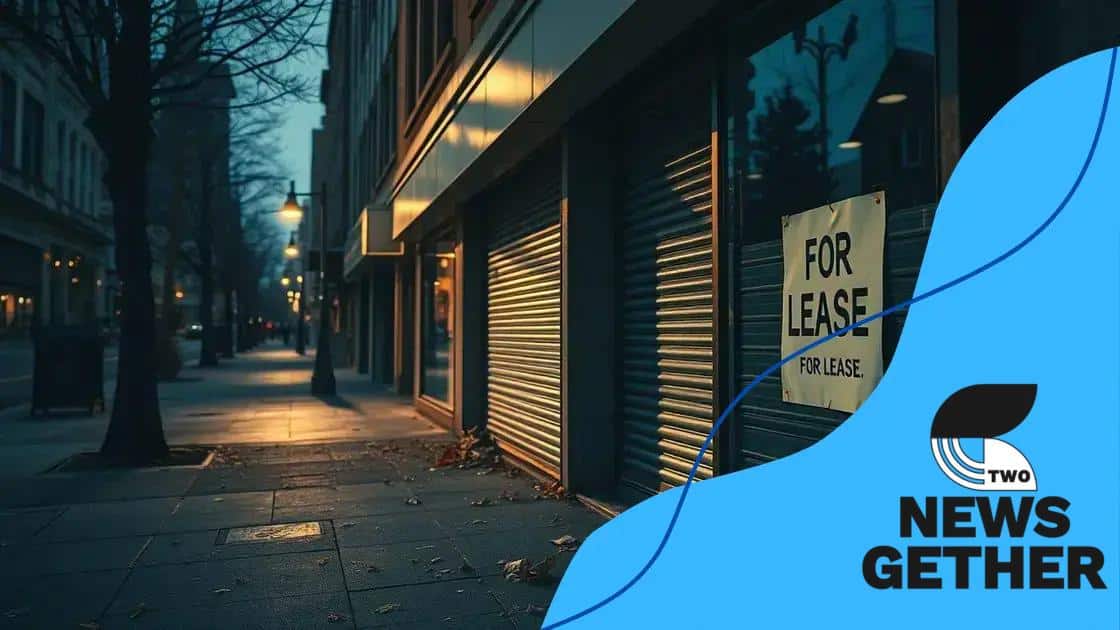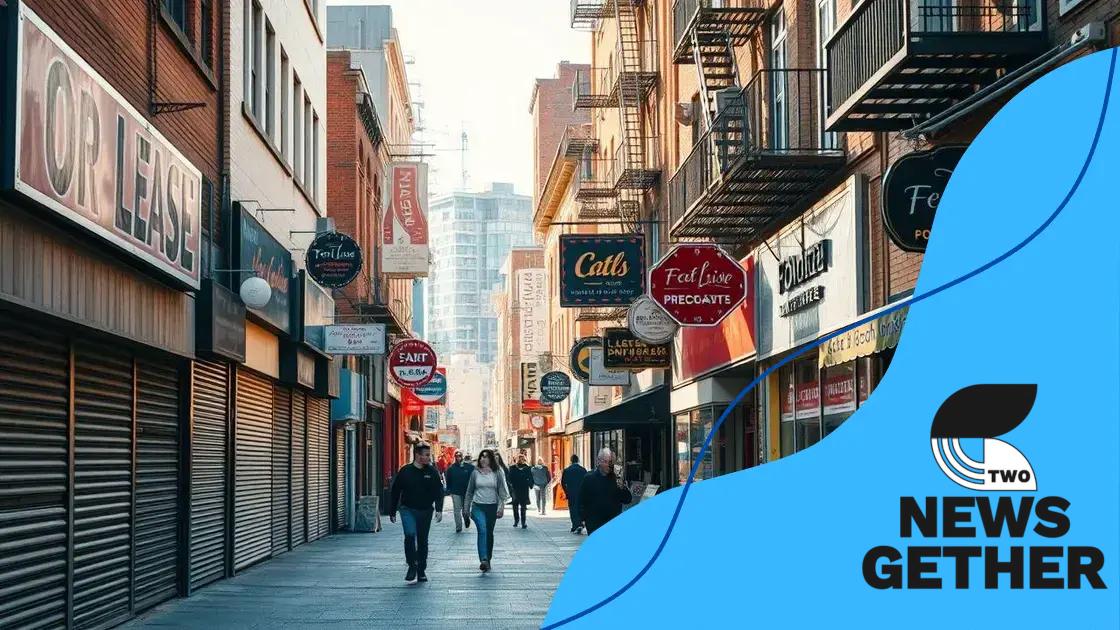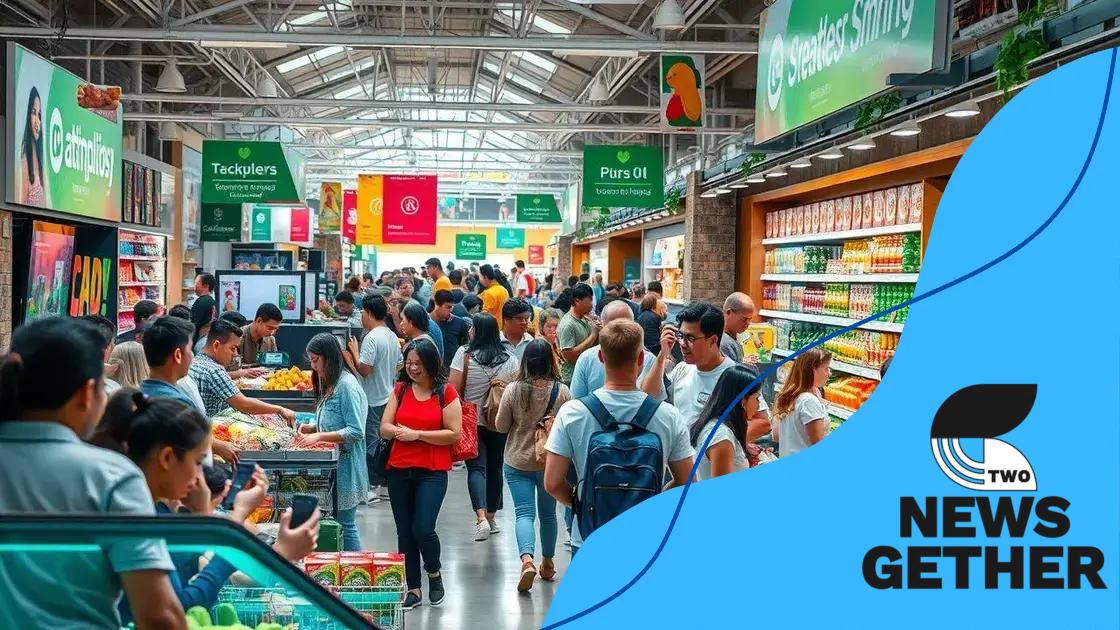Retail store closures May 2025: what’s next?

The future of retail will thrive by adopting technology, enhancing customer experiences, focusing on sustainability, and forming partnerships to meet changing consumer behaviors and preferences.
Retail store closures May 2025 are set to transform the shopping landscape. Have you noticed fewer stores in your neighborhood? Let’s dive into what this means for consumers and businesses alike.
Understanding the current trends in retail closures
Understanding current trends in retail closures is crucial for grasping the evolving landscape of shopping. Many familiar stores are disappearing from our streets, and this raises important questions about why it’s happening and what it means for consumers.
Major factors driving retail closures
Several key factors are contributing to the rise in store closures. Firstly, the increased adoption of online shopping has changed how consumers make purchases. Today’s shoppers often prefer the convenience of browsing and buying from their homes.
Changing consumer preferences
Additionally, there has been a noticeable shift in consumer preferences. Customers are seeking unique shopping experiences rather than standard retail offerings. This has led to many traditional stores struggling to keep pace.
- Digital transformation: Retailers must embrace technology to stay relevant.
- E-commerce competition: Online platforms offer convenience and often better prices.
- Experience over products: Shoppers value engaging experiences over mere transactions.
Furthermore, economic pressures have forced many retailers to re-evaluate their business models. Profit margins are shrinking, and brands are struggling to find ways to attract customers amidst fierce competition. Some companies are closing physical stores to focus on e-commerce initiatives. Others are seeking to innovate by enhancing in-store experiences to draw back customers.
While some brands have closed numerous locations, others have adapted by transforming their retail spaces. For instance, certain stores are now offering experiences like workshops, collaborations with local artists, or pop-up events. Such changes aim to create a sense of community and drive foot traffic.
Community impact of closures
The impact of these closures reaches beyond the companies themselves. Local economies suffer when stores shut down, leading to increased unemployment and reduced local spending. It’s essential to recognize that each closure represents not just a lost shopping option but also a ripple effect throughout the community.
In summary, understanding the trends in retail closures requires examining various factors, including changing consumer habits, economic conditions, and the rise of e-commerce. These elements blend together to shape the current retail environment and its future.
Key reasons behind the surge in store closures
Understanding the key reasons behind the surge in store closures is essential for grasping the shift in retail dynamics. Numerous factors play significant roles in this trend, affecting how and where consumers shop.
Economic challenges impacting retailers
One major reason for closures is the economic pressure faced by many retailers. Rising costs of rent and utilities have made it increasingly difficult for brick-and-mortar stores to sustain profitability. Additionally, inflation has diminished consumer spending power, leading customers to prioritize essentials over discretionary purchases.
The digital shopping revolution
The growth of e-commerce is another critical factor. As more consumers turn to online shopping, traditional retailers struggle to compete. The convenience of browsing and purchasing from home attracts shoppers away from physical locations. This trend has accelerated since the pandemic, with many consumers now preferring online transactions.
- Shift in shopping behavior: Customers are now accustomed to easy online access to products.
- Competitive pricing: Online platforms often offer lower prices, drawing budget-conscious shoppers.
- Wider selection: E-commerce provides access to a vast range of products not always available in local stores.
Moreover, changing consumer preferences contribute to this trend. Shoppers today value unique experiences and personalized services over traditional retail offerings. Many people seek out niche stores that cater to their specific tastes, leaving larger chains at a disadvantage.
Additionally, the rise of discount retailers and direct-to-consumer brands has further intensified competition. These businesses often operate with lower overhead, allowing them to provide attractive prices that lure customers away from established retailers.
Impact of the COVID-19 pandemic
The COVID-19 pandemic has also had lasting impacts on retail, prompting many stores to close permanently. Temporary closures during lockdowns led to significant revenue losses, making it impossible for some businesses to recover. As a result, many retailers were forced to make tough decisions regarding their future operations.
In summary, understanding the key reasons behind the surge in store closures helps reveal the complexities of the retail landscape. Economic challenges, the rise of e-commerce, changing consumer preferences, and the effects of the pandemic all intertwine to shape the future of shopping.
Impact on local economies due to closing stores

The impact on local economies due to closing stores is significant and often far-reaching. When a retail store closes, it doesn’t just affect the business itself; it can ripple through the entire community.
Loss of jobs and unemployment
One immediate effect of store closures is the loss of jobs. Employees who worked at these locations find themselves unemployed, leading to increased local unemployment rates. This loss of income affects not only the individuals but also their families and the wider community.
Reduced consumer spending
Additionally, when local stores close, consumer spending decreases. Residents lose shopping options, which can lead to money being spent outside the community instead. This shift can degrade the local economy, as fewer dollars circulate among local businesses.
- Decreased tax revenue: Store closures lead to lower sales tax, affecting community funding.
- Negative impact on supporting businesses: Nearby stores may also suffer from reduced foot traffic.
- Community services at risk: Less revenue can affect local public services and infrastructure.
Moreover, the closure of popular retail stores can change the character of a neighborhood. It’s not just about losing stores; it can also lead to a sense of desolation among residents. Local landmarks that once drew people to the area can be replaced with vacant storefronts, further discouraging new businesses from opening.
Furthermore, when large chains close their doors, the community can lose unique offerings that differentiate it from nearby towns. Local shops often provide personalized services that are not easily replicated online. This loss can diminish the community’s identity and make it less attractive to visitors.
Community initiatives and responses
To combat these challenges, some communities are taking proactive measures. Local governments may offer incentives to attract new businesses. These efforts can help revitalize areas affected by closures.
The impact on local economies due to closing stores reveals a complex interplay of financial and social factors. Each closure tells a story of lost employment, reduced spending, and diminished community spirit.
Shifts in consumer shopping habits and preferences
Shifts in consumer shopping habits and preferences have dramatically changed the way businesses operate. Today, customers are more informed and have distinct expectations when it comes to their shopping experiences.
Growth of online shopping
One significant shift is the increase in online shopping. Many consumers now prefer the convenience of shopping from home, especially since the pandemic. This has led to more people using their phones or computers to browse and make purchases.
Desire for personalized experiences
Furthermore, shoppers today seek out personalized experiences. They want recommendations tailored to their needs rather than generic options. Retailers are responding by utilizing data analytics to understand individual preferences better.
- Increased reliance on social media: Many shoppers discover products through platforms like Instagram and Facebook.
- Emphasis on sustainability: Consumers are increasingly favoring brands that prioritize eco-friendly practices.
- Value-driven purchases: More buyers are making decisions based on principles, such as ethical sourcing.
Additionally, the expectation for seamless omnichannel experiences is growing. Customers want to interact with brands across multiple platforms and expect those interactions to be consistent. For instance, they may want to browse online and pick up in-store or return items purchased online at a physical location.
The demand for immediacy has also risen. Shoppers appreciate fast shipping and instant access to products. As a result, businesses are re-examining their supply chains to meet these expectations efficiently.
Influence of reviews and social proof
Online reviews play a significant role in shaping consumer decisions. Today’s shoppers often check reviews before making a purchase. Positive feedback can strongly influence buying choices, while negative reviews can deter potential customers.
Shifts in consumer shopping habits and preferences are vital for retailers to understand. Adapting to these changes can help businesses remain competitive and relevant in a rapidly evolving market.
Future of retail: online vs. brick-and-mortar
The future of retail is a fascinating topic as online shopping and brick-and-mortar stores continue to evolve and compete. As technology advances, both shopping methods are adapting to meet consumer needs and preferences.
Growth of online retail
One major trend is the remarkable growth of online retail. More people are choosing to shop from the comfort of their homes. This shift is largely due to the convenience and speed that online shopping offers. With just a few clicks, customers can browse thousands of products, often at competitive prices.
Advantages of brick-and-mortar stores
However, brick-and-mortar stores still hold significant value. Many shoppers enjoy the experience of physically examining products before buying. Touching and trying out items can create a connection that online shopping cannot replicate. Furthermore, local stores often provide personalized customer service.
- Immediate product access: Customers can take their purchases home right away.
- Community interaction: Local shops foster a sense of community among residents.
- Enhanced shopping experience: Events and in-store promotions attract customers to physical locations.
Retailers are increasingly recognizing the importance of an omnichannel approach. This means blending online and in-person shopping experiences. For example, customers might browse products online and choose to pick them up in-store. This strategy not only provides convenience but also encourages customers to visit physical locations.
The future could see more integration of technology in physical stores. Concepts like augmented reality and interactive displays may enhance the shopping experience, bringing the best of both worlds together. Customers may enjoy personalized recommendations based on their browsing history while shopping in person.
Challenges ahead
While the future looks promising for both online and brick-and-mortar retail, challenges remain. Retailers must continue adapting to changes in consumer behavior and technological advancements. Staying competitive will require businesses to innovate and find unique ways to engage customers.
Overall, the future of retail is likely to be defined by a combination of both online and brick-and-mortar strategies. Balancing these channels will be essential for retailers aiming to thrive in a dynamic market.
Strategies retailers can adopt to thrive

To thrive in a rapidly changing market, retailers must adopt innovative strategies. As the landscape shifts, it’s crucial that businesses adapt to meet evolving consumer needs and preferences.
Embracing technology
One effective strategy is to embrace technology in all aspects of the retail experience. By implementing solutions like automatic inventory management systems, retailers can enhance efficiency. Additionally, utilizing customer relationship management (CRM) tools helps businesses understand their customers better.
Enhancing customer experience
Enhancing the customer experience is another key strategy. Retailers can create personalized shopping experiences by offering tailored recommendations based on previous purchases. Interactive features, such as virtual try-ons or in-store kiosks, also engage customers and make shopping more enjoyable.
- Omnichannel strategies: Providing a seamless experience across online and offline channels is essential.
- Flexible payment options: Offering various payment methods, including mobile wallets, caters to different customer preferences.
- In-store events: Hosting special events can attract customers and create community engagement.
Additionally, focusing on sustainability can resonate with socially conscious consumers. Many shoppers today prefer brands that prioritize eco-friendly practices. Incorporating sustainable products and reducing waste in operations can also been seen as a competitive advantage.
Monitoring market trends and staying informed about customer feedback is essential. Retailers that adapt quickly to changes in consumer behavior will have a better chance of success. Engaging with customers through social media and other platforms helps businesses understand their needs and preferences.
Collaborations and partnerships
Another approach is forming strategic partnerships. Collaborating with local businesses and artists can create unique offerings that set a retailer apart in a crowded market. These partnerships can also generate additional marketing exposure, benefiting all parties involved.
In summary, retailers can thrive by embracing technology, enhancing customer experiences, focusing on sustainability, staying informed on market trends, and forging partnerships. By implementing these strategies, businesses can better position themselves in an ever-evolving retail landscape.
The future of retail is marked by exciting changes and challenges. Retailers must adapt to new consumer behaviors and preferences to thrive. Embracing technology, enhancing customer experiences, and focusing on sustainability will help businesses stay competitive. Forming partnerships can also create unique opportunities. By implementing these strategies, retailers can respond effectively to the evolving market and meet the needs of their customers.
FAQ – Questions about the Future of Retail
How can retailers embrace technology effectively?
Retailers can adopt technology by implementing inventory management systems and CRM tools to improve efficiency and understand customer needs.
What role does customer experience play in retail success?
Enhancing the customer experience through personalized services and interactive features can lead to increased customer satisfaction and loyalty.
Why is sustainability important for retailers?
Sustainability attracts consumers who prioritize eco-friendly practices, helping retailers build a positive reputation and customer base.
How can partnerships benefit retailers?
Forming partnerships with local businesses can create unique offerings and increase marketing exposure, enhancing overall competitiveness.






